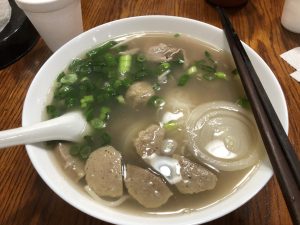Whenever someone would ask what my favorite dish is, there is always one thing comes to mind: phở, a warm and fulfilling bowl of Vietnamese beef noodle soup rich with carefully thin cuts of meat and fresh herbs. If one were to think about Vietnamese cuisine, phở would instantly come to mind as it is one of the most (if not the most) iconic foods of Vietnam. It is a dish that can be eaten at any time from the early hours of breakfast to the later ones of late-night cravings. In a sense, phở is the ultimate comfort food for any occasion. It is a way to bond with friends and family at any time while enjoying its full and wonderful taste. As for me, it is a reminder of my identity as a Vietnamese-American.
I was born and raised in the United States in a Vietnamese household, and while growing up, I had realized that I was in between two different cultures. Being outside of my home brought me up as an American constantly exposed to the bold flavors of American cheeseburgers and pizzas; however, being back at home would remind me of my Vietnamese roots and what authentic Vietnamese flavor really was. One of the most important ways my parents developed my palate was through simple but amazingly wonderful dish: phở. As a kid I would always know when my mom was making phở by taking in the rich aromatic scent of the broth steadily boiling in a humongous pot. My mom would call me over and ask whether I was able to smell the blend of the flavors and herbs in the broth, and sometimes she would even let me have a little taste to see whether the flavors were balanced to our satisfaction. After a long day of cooking, everyone in my family would sit down at the dinner table and enjoy every slurp of the noodle and sip of the broth while my parents would talk about how tasty Vietnamese food can be. No matter how picky of an eater someone in the family was, phở would always be enjoyed by everyone regardless of his or her palate; it was a stepping stone of sorts to Vietnamese cuisine. The beginnings of my enjoyment and appreciation for Vietnamese food are some of my fondest memories, and I am truly glad that phở has made a major contribution.
The beginnings of phở were relatively recent compared to other iconic dishes such as noodles or pasta. It first appeared in the northern region of Vietnam in the late 1800s as a simple dish of noodle soup with a few cuts of meat. Eventually, the knowledge of the dish traveled to the south as the country split into North Vietnam and South Vietnam during the Vietnam War. Interestingly, when the dish moved south, it was slightly modified so that it is served with crunchy mung bean sprouts and fresh herbs such as basil. Therefore, two distinct styles of phở emerged to represent the culinary preferences of each region after the country was reunified from the war. Refugees from the war brought the recipe of phở (particularly the Southern style) to other countries such as the United States when they fled. As a result, phở has become a well-known dish outside of Vietnam that anyone can enjoy. What makes phở unique in particular is the influence of French and Chinese cooking on it. The noodles and the spices that add to the flavor came from China, but the broth preparation and the use of red meats came from France. In fact, the word phở most likely came from the French term pot-au-feu, meaning “pot on the fire.” This is representative of the cooking process in which the pot is boiled with the beef bones for several hours before it is ready. After the broth is prepared, thin cuts of sirloin are added along with the rice noodles and cooked by the boiling-hot broth as it is poured into the bowl. As a result, this hybrid of Eastern and Western cuisine has resulted in a perfect blend of flavors that people of both cultures can enjoy.
Pictures:

Here is a picture of a typical bowl of pho.

This is a picture of me with my mom, sister, and girlfriend.
Recipe for Southern-style phở:
Ingredients:
5 lb of beef bones (knuckle) or oxtail bones
2 yellow onions
1 spice packet containing cinnamon, cloves, star anise, coriander, and cardamom
¼ cup of fish sauce (nước mắm)
2 lb of rice noodles
½ lb eye of round sirloin
2 scallions
1/3 cup of chopped cilantro
3 cups of mung bean sprouts
Basil for garnish
Lime cut into wedges
2 jalapeño peppers cut into slices
Hoisin sauce
Sriracha
Steps:
- Boil the beef bones in a large pot with water covering the bones for about 10 minutes to boil out any impurities.
- Drain the bones of the water containing the impurities and refill the pot with water again to cover the bones. Boil the bones with the spice packet and one yellow onion at a gentle simmer for about 8 hours until all of the flavors from the bones and spices come out. Skim off any fat that comes up from the cooking process.
- Liberally add fish sauce to season the broth with saltiness until the flavor is to your satisfaction. Constantly taste-test to check the balance of flavor.
- Cut the sirloin steak against the grain into thin slices. The thinner they are, the faster they will cook when the broth is poured over it.
- Chop a yellow onion and all the scallions into slices to be added to the bowls.
- When it is time to eat, prepare the bowls of pho with the desired amount of rice noodles along with a liberal amount of mung bean sprouts, onion, and scallions.
- Add the desired amount of sirloin slices into the bowl and ladle the hot broth into the bowl. It should cook the slices in a few seconds as it turns from red to a well-done gray-brown.
- Add cilantro, basil, and jalapeño pepper slices to garnish the phở along with the desired amount of Hoisin sauce, Sriracha, and squeezed lime wedges to season it to satisfaction.

Hi, Thomas, thanks for sharing such a wonder dish with us. Pho is a well-loved dish by millions of people in the US, and I’m sure even within our class, there’ll be quite a few fans. I’m glad you can have a chance to reunite with your Vietnamese identity through the constant access to traditional foods and culture. Your mom seems quite the chef, teaching you how to identity by smell various herbs and ingredients. I like the idea that pho could be regarded as “a stepping stone” to Vietnamese cuisine (or even its culture, to some extent). I would encourage you to think further along the lines of food and memory–apart from providing some of the fondest memories, do you find pho significant in other aspects of your self-perception? Are there any other ways that your experience of pho has impacted your understanding of yourself, your family and Vietnamese and mainstream American culture? How do you arrive at a balanced conception of the two different cultures in relation to pho? Thanks for the lovely family photo!